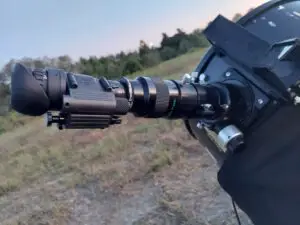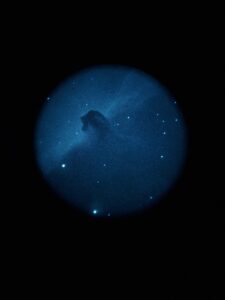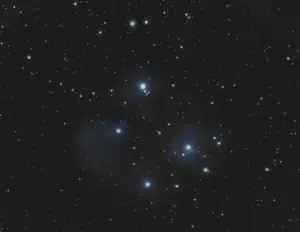One of the questions I hear the most in astronomy groups is, “Which is the best beginner’s telescope?” There are many options in the category, but few worth buying.
In this article, we’ll look at a promising new model from Antares: the 511AZ reflector.
Specifications
Aperture: 114mm
Focal length: 500mm
Focal ratio: f4.4
Price: Khan Store is the supplier of this scope, find the current price at the Khan Scope store.
First Impressions
The 511AZ is a short-focus reflector on a manual altazimuth mount. It comes supplied with a 14mm eyepiece, 3x barlow lens, moon filter, and red dot finder, and is attached to a lightweight aluminum tripod with extendable legs and a plastic eyepiece tray.
I was especially curious when I saw that the 14mm eyepiece has an 80-degree apparent field of view, which is unheard of at this price!
Sounds almost too good to be true.
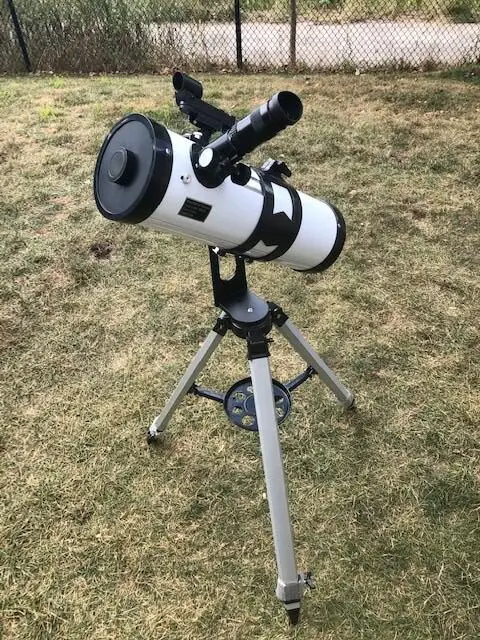
The kit comes packed in a conspicuously long, skinny box. That is because it arrives fully assembled from the factory; there is literally no assembly required!
The single-arm fork mount has a carry handle built into it, so you can just lift the entire thing out of the box and carry it outside.
I thought this was a great feature, which was also different from what was pictured on the Antares website. (It shows a solid fork arm with no cutout.)
The optical tube assembly (OTA) is painted white with black accents, presenting a straightforward, no-nonsense appearance.
The OTA is secured to the mount by a pair of joined tube rings with a wing nut-style screw. This is a nice feature which allows you to loosen the screw and slide the tube back or forth to adjust balance if necessary.
The unit comes equipped with a 1.25” rack and pinion focuser. The focuser looks rather flimsy, and I expect it to be a weak point of this telescope.
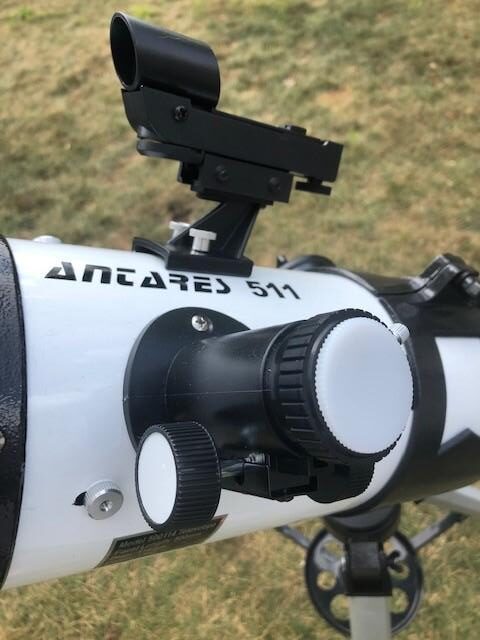
The Antares website doesn’t indicate what type of mirror was employed in this telescope.
Looking down the drawtube with the eyepiece removed, I was unable to see the entire primary mirror reflected in the secondary.
This might have been done to reduce edge-of-field aberrations, but it also reduces image brightness. There is no center marking on the mirror to aid in collimation.
The primary and secondary mirror both use Philips screws for adjustment. I did not try collimating my test scope, but it doesn’t appear to be the most user-friendly design in that respect.
I have especially high hopes for the mount.
In my experience, side-mounted single arm fork designs are more stable and better balanced than top-mounted designs such as on the Synta AZ3 or Astromaster AZ mounts.
There is a tension control knob on the altitude axis but not the azimuth; a wrench will be required to loosen or tighten the azimuth tension. The aluminum tripod is extremely light-duty and will likely be another weak point.
In the Field
Setup of this scope could not be any easier: I carried the whole kit outside in one hand, spread the tripod legs, and that was it!
With the tripod legs retracted all the way, I found the eyepiece was almost the perfect height to look through while seated in a regular patio chair. This also provides maximum stability compared to having the legs extended.
The AZ mount proved just as good as I’d hoped.
The mount operates exactly as a tabletop Dobsonian, swiveling up and down and side to side smoothly and staying where you point it without sagging or drifting.
Once I had the altitude tension adjusted, the scope never seemed out of balance, even when using heavier eyepieces like my 17.3mm Delos.
The mount also gives you freedom to point anywhere in the sky and can easily point to zenith.

The red dot finder was easy to align.
Once this was done, the telescope was a breeze to use.
With the supplied 14mm eyepiece, panning around the summer Milky Way was simple and fun. Read more about eyepiece specifications in this article.
Unlike so many eyepieces supplied with cheap telescopes, this one has a very wide field of view and comfortable eye relief.
This makes a tremendous difference in my observing, allowing me to stay engaged with the views. Edge-of-field aberrations were minimal for an f4.3 optic, certainly much better than I was expecting.
I didn’t try to measure the apparent field of view of the eyepiece, but if we take the published specs at face value, this yields 36x magnification with a 2.2-degree true field of view; perfect for locating deep sky objects!
I found half a dozen Messier objects in a few minutes, by memory or using a smartphone app, and even a couple by accident as I was randomly panning around.
This wide field of view is ideal for a beginner, who would most likely struggle with the narrower field of a long refractor, for instance.

One issue with using an f4.3 mirror is a shallow depth of focus. This telescope moves in and out of focus fast, and the focus adjustment requires a very soft touch.
This is where a higher-quality focuser would come in handy, especially when using the 3x barlow lens. I found it a bit tricky to dial in the focus at 108x magnification.
The other main issue with using this scope is the tripod.
Vibrations are pronounced and take several seconds to settle, especially while focusing. A heavier tripod would improve things, but at a greater weight and cost.
In astronomy, there are always trade-offs one must make.
The telescope can be purchased only from Khan Scope.
What Can You See with the 511AZ?
I found this telescope was at its best when just leisurely exploring the heavens.
The absence of locking clutches on the mount head gives you the freedom to roam around the sky as opposed to having to always aim somewhere specific. The images from the 4.5” mirror aren’t very bright, but you can still pick up a lot of stars with it, especially from a dark location.
I observed a number of Messier objects from my Bortle 6 yard: M2, M11, M13, M27, M57, and more. For the most part, they had a similar appearance: faint, fuzzy balls with little detail.
If you are hoping to see exquisite detail in nebulae, you will need a bigger or better scope than this. I could barely resolve stars in M11.
I believe part of the reason is that the secondary mirror is too small and doesn’t reflect the entire primary image into the eyepiece.
In any case, the wide field is better suited to large targets. The Coathanger Cluster was nicely framed in the 511AZ. The Pleiades and Beehive clusters should look wonderful as well.
I had a nice view of Saturn using the 14mm eyepiece and 3x barlow lens. There wasn’t much detail, but the view still looked sharp with a good view of the rings. The nearly full moon also showed well. I tried the Crystalview moon filter, but it didn’t seem to make much difference.
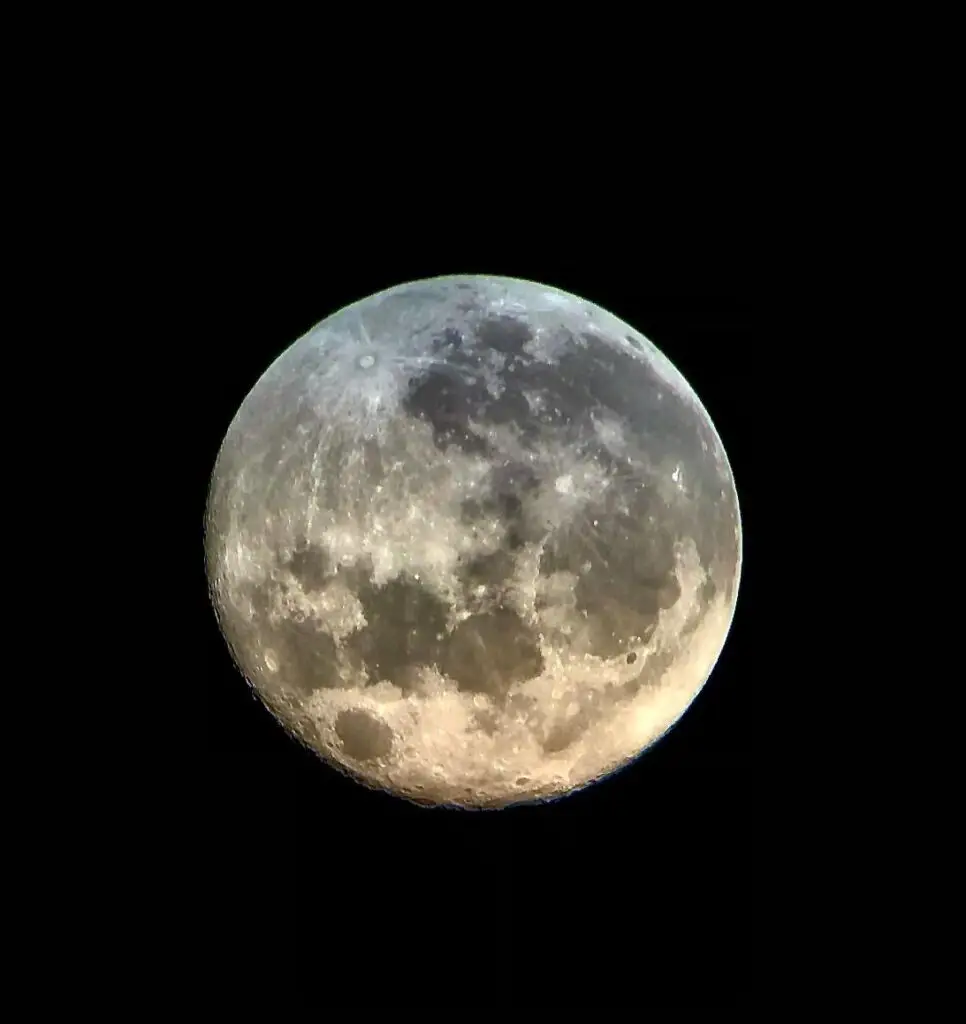
Is the Antares 511AZ the Perfect Beginner Scope?
Unlike most cheap telescopes, the Antares 511AZ is a capable instrument which will provide more fun than frustration.
I enjoyed using it over a couple of nights and would recommend it to anyone looking for their first telescope.
Like any instrument in this class, there are some limitations you should be aware of. This might even be a suitable second telescope for a more experienced astronomer looking for a grab-and-go kit, or something to use with children.
Pros
- Smooth and stable mount.
- Quality accessories.
- No assembly required.
- Easy to carry one-handed.
- Wide-field views.
Cons
- Focusing can be a challenge.
- Difficult to collimate.
- Wobbly tripod.
- Limited to low and medium power.
Similar Models
If you have trouble finding this scope, there are a few similarly priced, comparable models that are a bit easier to find.
Celestron Astromaster 114AZ

